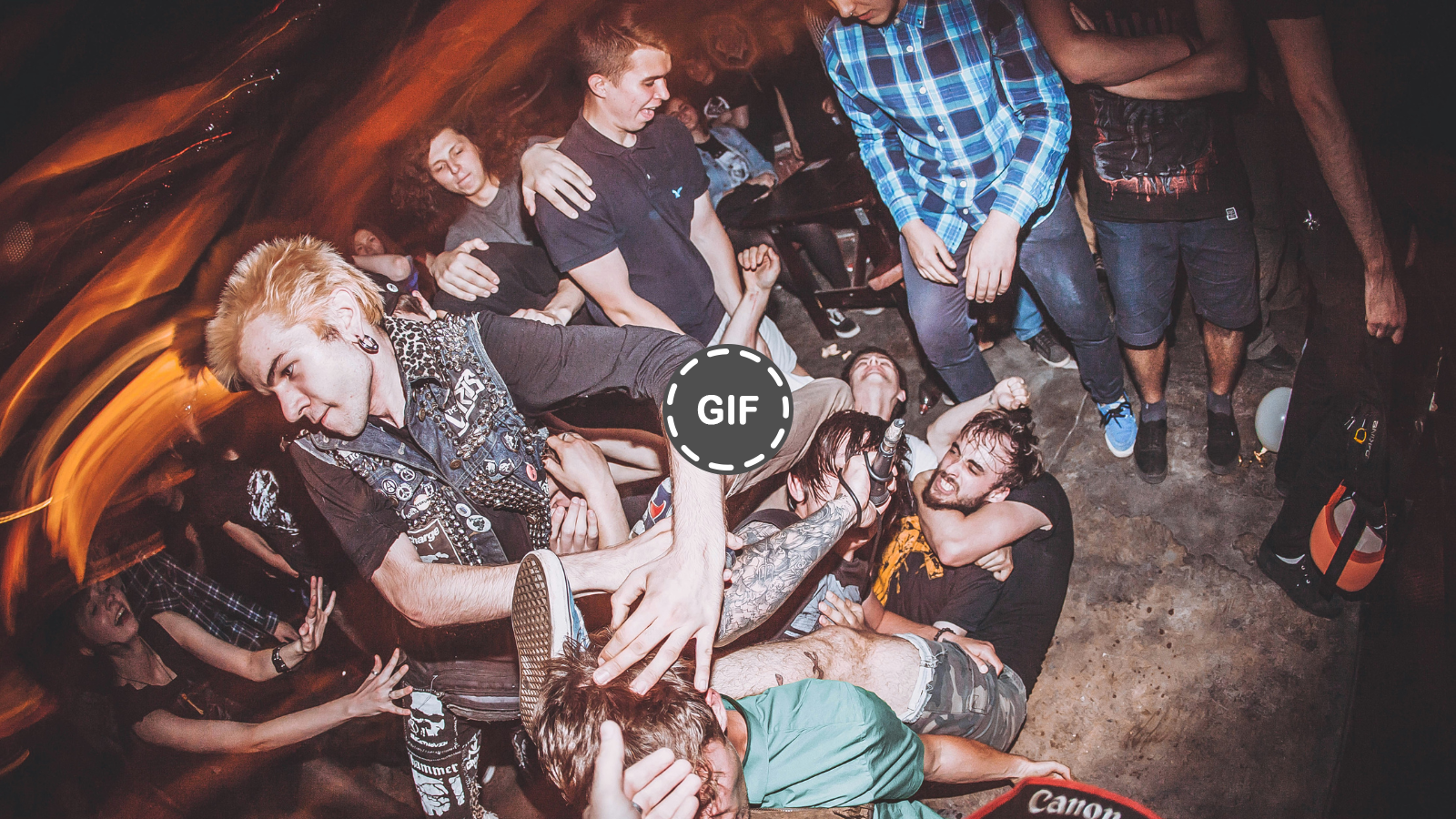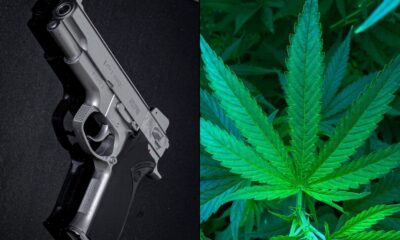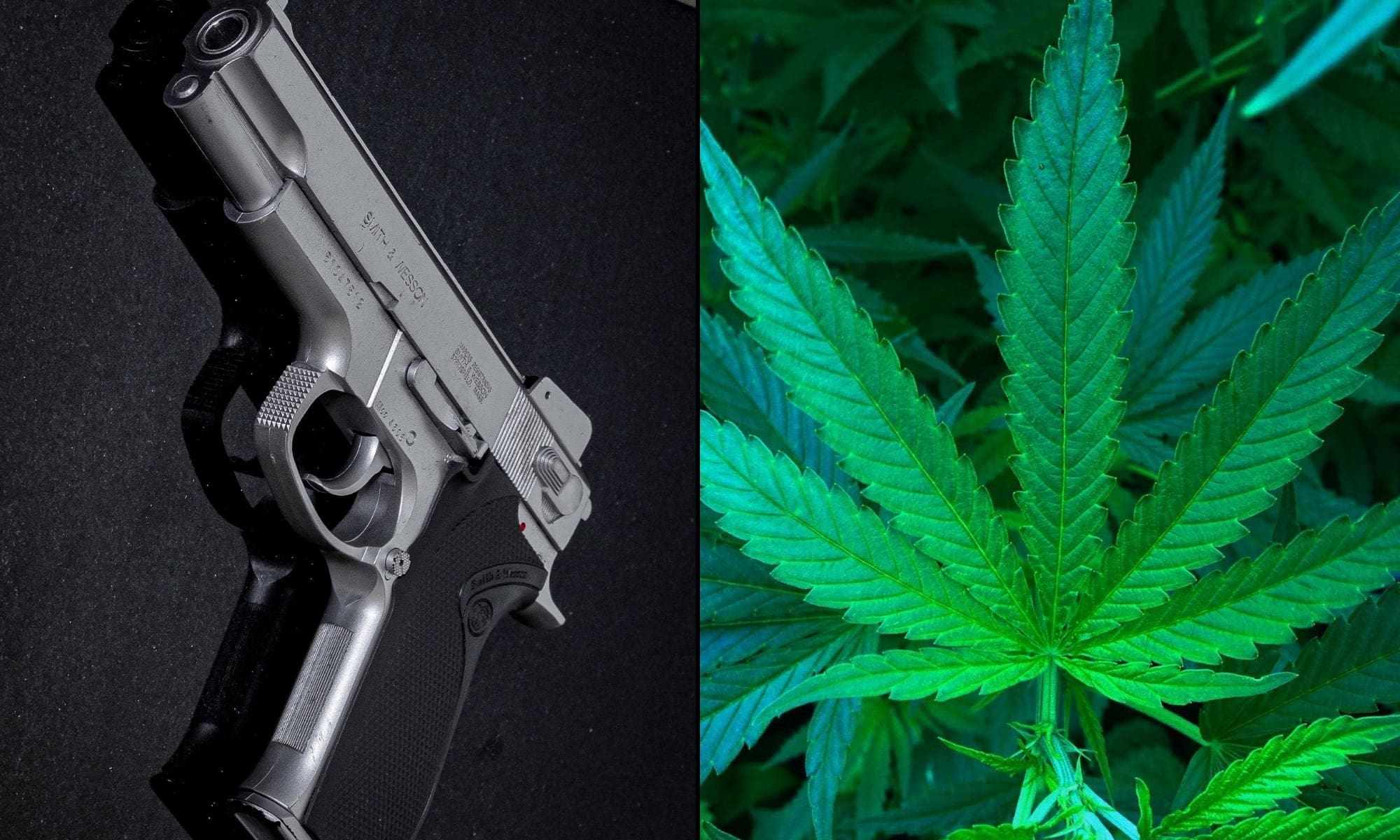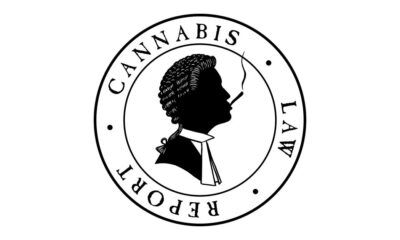featured
The Creature from the Black Leather Lagoon
Published
3 hours agoon

April 18th, 1977. Hollywood, CA.
There was something foul and electric in the air that Monday night at the Starwood. The kind of charge you only find when the floor’s slick with beer and the crowd reeks of leather, cigarettes, and bad choices. The volatile energy of a live wire hissing on a wet dance floor—spitting, sparking, waiting to kill whoever got too close.
The room was a zoo of freaks—burnouts with thousand-yard stares, thrill junkies itching for damage, leather-clad criminals with joints glued to pierced lips, and the occasional college zombie dragging a terrified date into the pit.
The air was swamp-thick: sweat, stale PBR, clove smoke, and always weed. Heavy clouds slithered low across the crowd like cold glycerin—a false floor drenched in Blade Runner-neon—perfumed with Acapulco Gold, Thai Stick, Golden Voice.
Then The Damned hit. And whatever fragile order had been holding the room together dissolved into lawless beauty.
Captain Sensible hunched over his bass like Gollum rigging dynamite. Rat Scabies vanished behind a drum kit that looked ready to detonate. Brian James hacked his guitar like Norman Bates in a thrift-store suit, tie clinging on like a hostage.
And then Vanian. A ghoul from a Hammer Horror reel. He ripped off a vinyl mask to show the real mask beneath: hospital-white skin, slick black hair, eyes wide and vacant like possession. As though the dark itself was being torn inside out. His voice was an exorcism.
They tore into the Stooges’ “I Feel Alright” at double-time, guitars squealing like pigs on the block. Vanian stalked the stage in spasms—half epileptic fit, half black-mass sermon. The stage rattled like a runaway freight train.
You either surrendered to the blitzkrieg or fled to the bar.

Blood in the Pit
That was SoCal punk then. Step into the pit and you stumbled away bruised, soaked, bleeding from god-knows-where, but alive in a way suburbia could never manufacture.
A busted lip was simply proof of purchase. Cig burns on your jacket were rites of passage. Kids got concussed and came back swinging, arms pinwheeling in the pit like upturned helicopters.
Violence wasn’t the point, but it always came with the territory.
By the late ’70s, rock ’n roll had abandoned a generation. The kids who were left out did what the ignored always do: turned basements, ballrooms, and half-legal vet halls into sanctuaries.
And through every room drifted the same fog: weed smoke. Not a garnish, but an essential ingredient. A fifth band member with no name, hanging in the rafters.
Thai Stick joints smoldering to black nails. Acapulco Gold changing hands in parking lots like secret handshakes. Seeds and stems surgically removed with the reverence of an Itamae shaving toro.
Weed was the battery. The voltage in the circuit.
The Outlaw Benefactor
But punk didn’t pay. Five-dollar tickets and photocopied flyers couldn’t keep the lights on. The kids were broke, the bands broke, the clubs hostile. So who kept the ears ringing?
Behind the distortion stood a man most never saw: Gary Tovar—smuggler, outlaw businessman, and the unlikeliest patron saint SoCal punk would ever know.
Born in Los Angeles in 1952, carted off to Huntington Beach at twelve, and dropped into the sun-bleached sprawl where surfers, burnouts, and suburbanites collided, Tovar did the responsible, junior-college circuit—Golden West and Fullerton colleges, the polite conveyor belt of mediocrity—but the truth is he’d already been running his own education for years. By his teens he was a border hustler, smuggling fireworks out of Tijuana with the kind of nerve no textbook could teach.
Soon enough, those extracurricular activities were going to drag him into a new and legendary direction—the kind that starts with a boot on the gas and ends with sirens in the rearview. Where the border was a revolving door and authority was something to be toyed with.
Tovar’s first hit of punk came at Winterland in ’78, watching the Sex Pistols flame out in a blaze of piss and nihilism. But it was his kid sister, Bianca, who pulled back the curtain on what was happening closer to home. Cops were strangling SoCal shows in real time—raids, shutdowns, boots on kids’ necks—and the crackdown only made the bands louder.
To a 20-year-old pirate with cash to burn and an appetite for trouble, that was enough. Punk was worth fronting. Worth pouring gas on until the scene caught fire.
“I saw the culture. I wanted to push it as far as I could,” Tovar said later in an interview with OC Weekly. “Expose it to as many people as possible. There were a lot of good ideas getting a lot of resistance. And I think we won.”
Tovar funneled the money back into the scene. Booking bands no one else would touch. Renting halls respectable promoters wouldn’t risk. Setting fire to his own fortune for the cause.
Punk was the new sound. Weed was the currency. And with Tovar at the wheel, they were building a movement that would mutate into something nobody in that smoke-choked room could have ever imagined.
Zodiacs in the Dark
Gary never looked like a punk promoter. He looked like what he was: a hustler with a gambler’s grin and saltwater on his breath.
He didn’t begin as a kingpin. He began with fireworks—Roman candles smuggled past customs when he was a kid. If you can move rockets, why not reefer? Why not burlap sacks of fat buds hidden under cargo no one bothered to check?
After all, courage comes from the belly. All else is desperation.
By the late ’70s, he was one of California’s biggest cannabis free-traders. Freighters in Asia. Hand-offs at sea. Fishing boats ferrying the goods closer to shore. Zodiacs racing through salty marine layer to unload on deserted stretches of coast. Cloak-and-dagger stuff. Something out of a Len Deighton Cold War novel, except the new enemies weren’t the Soviets—it was the DEA.
Smuggling weed back then was all about faith. Faith in timing, in loyalty, silence. You trusted the ocean to hide you, and your crew to keep their goddamn mouths shut.
Coast Guard spotlights sweeping the water like state-run eyes of Sauron. Helicopters thundering overhead. Smugglers crouched on a beach, sand clinging to sweat, praying the Zodiacs had already melted into the scenery. You learned to live with paranoia, because paranoia kept you breathing.
And yet Tovar kept running loads, more for purpose than for profit. Instead of burying his cash in condos or gold watches, he poured it into punk.
In 1981, when most promoters wouldn’t touch hardcore for fear of cops, fistfights, or trashed venues, Tovar leaned in. Put down deposits on the punk scene. He flew in British acts like GBH and The Adicts, backed Black Flag and Circle Jerks, rented hostile halls like the Olympic Auditorium.
He paid bands fair when others stiffed them. Punk bands didn’t care about the Top 40—they were after the new sound. And Tovar was the quiet backer with deep pockets who wanted to fund their wildest dreams.
Goldenvoice—Tovar’s promotion outfit, named after a Thai strain he claimed “sounded like angels singing in a golden voice”—became the crooked backbone of SoCal punk. Stamped on flyers, whispered about in backrooms.
On paper, Tovar lost millions. In practice, he bought a revolution.
Without his runs of Thai and Acapulco, there’s no TSOL and Shattered Faith at La Casa de la Raza. No Exploited and UK Subs at the Olympic. No Samhain and Necros tearing down the Stardust Ballroom. Nights that would have never made it past soundcheck.
Smoke was the receipt for every busted lip and burned dollar Tovar poured into punk.

The Bill Comes Due
It couldn’t last. Nothing gold does.
March ’91. Dawn. The DEA kicked his door in. Tovar’s double life snapped shut. It didn’t come as a surprise—the bootlegger circuit was already splintering—the war on drugs was at full tilt. Reagan’s mandatory minimums had crystallized the air everyone breathed. ‘Just Say No’ wallpapered over every school in the country, a moral branding iron for an entire generation.
Tovar had gotten too successful. Too visible. Too loud to ignore.
The bill came due.
He pled guilty to trafficking and spent seven years in federal prison. Seven years to replay the reels: fireworks as a teen, freighters in Asia, keeping punk alive one night at a time.
The Velvet Noose
The timing was especially cruel. Just as Goldenvoice was becoming legend—nights that left you bruised but smiling—Tovar lost it. The cuffs clicked, and he handed it over to Paul Tollett and Rick Van Santen.
They kept the name alive. But by the late ’90s, Goldenvoice—the weed-fueled carnival Tovar built—created something its younger self would’ve puked on: Coachella.
The corporate, desert bacchanal of VIP tents and $40 cocktails. From Thai Stick in a Hollywood pit to influencers posing in Indio.
An evolution so cynical it could’ve been a joke.
At the Starwood, you risked a busted nose, maybe a knife fight. At Coachella, you risk sunburn and overpriced rosé. The grit has been scrubbed off, replaced by curated Instagram backdrops and brand activations. The kids once locked out of venues are now locked out by ticket prices.
Goldenvoice may be corporate now, but its roots are resin-soaked. Its name is written in the DNA of a crashing wave that was meant to break once it hit the California coast.
At the core of America’s biggest festival runs a deep current of punk weed lore.

Blood, Smoke & Feedback
Like the plant, Tovar thrived on the margins. Like the plant, he built community where there was none. And like the plant, he was punished for it—caged, stamped a criminal—even as the scene he funded bled ragged into the mainstream.
Now cannabis comes sealed in child-proof plastic. Punk is nostalgia on Spotify, repackaged as background noise for Taco Bell commercials. Coachella is a corporate sandbox of wristbands and influencers elbowing for the best Heineken-sponsored selfie.
But scratch the glossy veneer and Tovar’s fingerprint is still there. You can hear it in the rumble of a hardcore reunion. See it in growers still chasing landrace purity. Smell it in the blunt passed around at the edge of a Turnstile pit. The spirit didn’t die, but it’s forever mutated.
And that’s the pattern. Outlaw culture gets mined, sanitized, sold back to the masses. Jazz clubs. Punk pits. Cannabis farms. The cycle doesn’t stop. The only question is who keeps the spirit alive when the money men move in.
That’s why Gary’s story matters. Not as trivia, but as proof that any culture worth a damn is born underground, sustained by those reckless enough to bankroll it against all odds.
For SoCal punk, weed was the blood.
Music, the drug.
Coachella’s the hangover.
The rest is just smoke.
This article is from an external, unpaid contributor. It does not represent High Times’ reporting and has not been edited for content or accuracy.

Author: mscannabiz.com
MScannaBIZ for all you Mississippi Cannabis News and Information.
You may like
-


No One Is Giving Your Kids Marijuana Edibles in Their Halloween Candy
-


Florida Case On Medical Marijuana Patients’ Gun Rights Is On Hold As Supreme Court Weighs Underlying Issue
-


CULTA Appoints Cannabis Industry Veteran Joseph Andreae as CEO
-


Cannabis industry case challenging prohibition hits Supreme Court (Newsletter: October 27, 2025)
-


I Worked a Day as a Budtender in Brooklyn: Here’s What I Learned
-


Trump’s ‘Stupid’ Drug War Killings Put Military In Untenable Position, Former GOP Attorney General Of Idaho Says (Op-Ed)
featured
No One Is Giving Your Kids Marijuana Edibles in Their Halloween Candy
Published
13 minutes agoon
October 27, 2025

It’s Halloween season, which means it’s time for your local news outlets to once again warn viewers about a virtually non-existent threat: the notion that there are large groups of insidious people just waiting to give your trick-or-treating children free cannabis edibles. This is one of those marijuana myths that keeps coming back from the dead every time the pumpkins start popping up on your neighbors’ doorsteps.
No one is knowingly giving out edibles to children as Halloween candy. First, doing so would be grossly irresponsible. NORML’s longstanding ‘Principles of Responsible Cannabis Use’ specify that cannabis is for “adults only” and that consumers “do not violate the rights of others.” Second, it would be cost-prohibitive. Regulated cannabis products cost exponentially more than traditional candy. Third, doing so exposes would-be pranksters to serious criminal penalties, as distributing cannabis to minors is a felony offense in almost all circumstances. Fourth, legal state-regulated cannabis products are subject to strict packaging laws that make them readily distinguishable from traditional candy, as well as from irresponsibly packaged unregulated products. For these reasons, there are few, if any, reports of this happening in the real world, only in the minds of ratings-crazed newsrooms and fear-mongering prohibitionists.
There will always be a very small number of people with malicious intentions and, as a result, parents should always check their kids’ Halloween haul to ensure that their treats are safe and appropriate. That goes without saying. But there’s no data to support the unfounded claims that the statewide regulation of either adult-use or medical-use cannabis products is unduly putting children’s safety at risk — not on Halloween or any other day of the year. In fact, over the past decade, marijuana use by teens has fallen to historic lows.
Writing for NBC News, journalist Simon Moyer-Smith said it best:
“Halloween, of course, is a time of fear: ghouls, goblins, haunted houses and the sheer volume of leftover candy that will be around to tempt you. But it’s not a time to stoke fear about things that aren’t based in evidence and truth — and definitely not a time to demonize marijuana yet again.
… No one, absolutely no one, will be handing out marijuana edibles en masse to unsuspecting minors this Halloween. … If you want to be scared of something on Halloween night, it shouldn’t be edibles in your kid’s treat bag but drunken drivers on the road.
… So fear demons, drunk drivers and Dum Dums, but there’s no need to worry that edibles will be given out willy-nilly to trick-or-treaters on Halloween.”
So go ahead NORML Nation, have a fun, safe, and evidence-based Halloween – and of course, enjoy your edibles responsibly and keep them safely out of the hands of children.
Related

Author: mscannabiz.com
MScannaBIZ for all you Mississippi Cannabis News and Information.
featured
Florida Case On Medical Marijuana Patients’ Gun Rights Is On Hold As Supreme Court Weighs Underlying Issue
Published
1 hour agoon
October 27, 2025
A federal court has agreed to delay proceedings in a years-long Florida-based case challenging the constitutionality of the ban on gun ownership by people who use medical marijuana, with the Justice Department arguing that the U.S. Supreme Court’s recent decision to take up a related dispute warrants a stay in the lower court.
The Supreme Court accepted a petition for cert for the separate case, U.S. v. Hemani, last week to settle the question of whether the ban—known as Section 922(g)(3)—is consistent with the Second Amendment.
With that potentially precedent-setting judgement now pending, DOJ submitted a motion—which was unopposed by the plaintiffs—requesting that the U.S. District Court for the Northern District of Florida hold the matter at least until “the Supreme Court’s resolution” in Hemani.
The Trump administration further said a pause in the proceedings is necessary due to the government shutdown, which has deprived DOJ of resources and prohibits the agency’s attorneys “from working except in certain limited circumstances.”
“Granting a stay would promote judicial economy and the efficient use of resources of the Court and the parties,” it said. “The resolution of Hemani will almost certainly have a significant impact on this case. The Supreme Court’s ruling on the constitutionality of § 922(g)(3) will likely shed significant light on the viability of Plaintiffs’ claims here and what factual development, if any, is necessary to determine whether the application of § 922(g)(3) is constitutional as applied to Plaintiffs.”
Chief U.S. District Judge Allen Winsor agreed in a brief order issued on Thursday.
“Defendants’ unopposed motion to stay pending resolution of United States v. Hemani (ECF No. 41) is GRANTED. This case is STAYED, and all deadlines are suspended,” he wrote. “Any party may move to lift the stay at any time.”
The plaintiffs in the Florida case are Vera Cooper and Nicole Hansell, who are registered medical cannabis patients denied gun purchases over their admission to participating in the program, and Neill Franklin, a former police officer who wants to access medical marijuana without jeopardizing his right to own a firearm.
In August, a three-judge panel of the U.S. Court of Appeals for the Eleventh District, in a opinion authored by Judge Elizabeth Branch, departed from the district court’s earlier ruling that upheld Section 922(g)(3). It was a win for the plaintiffs, though the case was remanded back to the lower court and remains unsettled.
Former Florida Agriculture Commissioner Nikki Fried (D) initially led the suit against the federal government, but she was removed from the case after leaving her state office. The Republican commissioner who replaced her declined to become involved in the legal proceedings. Fried is now chair of the Florida Democratic Party.
While the Supreme Court last Monday also declined to take up a separate case on cannabis consumers’ gun rights, there are still several others pending a decision from the justices. But the choice to take up Hemani in particular is likely welcome news to the Justice Department, which has consistently defended the firearm prohibition and specifically requested that SCOTUS review that case instead of alternatives.
That could be related to the fact that the defendant is not only a marijuana consumer but also a user of cocaine who’s sold drugs in the past, so it’s possible DOJ reasoned that he is a less sympathetic face for the issue. Defendants in the other cases were merely found in possession of both a firearm and marijuana.
In June, U.S. Solicitor General D. John Sauer, an appointee of President Donald Trump, submitted a filing with the Supreme Court that said “Section 922(g)(3) complies with the Second Amendment,” and the statute “targets a category of persons who pose a clear danger of misusing firearms: habitual users of unlawful drugs.”
The law “bars their possession of firearms only temporarily and leaves it within their power to lift the restriction at any time; anyone who stops habitually using illegal drugs can resume possessing firearms,” Sauer said.
Notably, while the government mentions “habitual” users of illegal drugs 40 times in its filing, that word does not itself appear in 922(g)(3). The language of the statute prohibits anyone “who is an unlawful user of or addicted to any controlled substance” from purchasing or possessing firearms or ammunition.
In a separate August filing for the case, the Justice Department also emphasized that “the question presented is the subject of a multi-sided and growing circuit conflict.” In seeking the court’s grant of cert, the solicitor general also noted that the defendant is a joint American and Pakistani citizen with alleged ties to Iranian entities hostile to the U.S., putting him the FBI’s radar.
The court also recently denied a petition for cert in another gun and marijuana case, U.S. v. Baxter, but that wasn’t especially surprising as both DOJ and the defendants advised against further pursing the matter after a lower court reinstated his conviction for being an unlawful user of a controlled substance in possession of a firearm.
A number of federal courts in recent years have cast doubt on the legality of § 922(g)(3), finding generally that while the ban on gun ownership among drug users may not be entirely unconstitutional, there’s scant historical precedent for such a broad restriction of Second Amendment rights on an entire a category of people.
Meanwhile, in recent interviews with Marijuana Moment, several Republican senators shared their views on the federal ban on gun possession by people who use marijuana—with one saying that if alcohol drinkers can lawfully buy and use firearms, the same standard should apply to cannabis consumers.
Separately, the U.S. Court of Appeals for the Tenth Circuit last month sided with a federal district court that dismissed an indictment against Jared Michael Harrison, who was charged in Oklahoma in 2022 after police discovered cannabis and a handgun in his vehicle during a traffic stop.
The case has now been remanded to that lower court, which determined that the current statute banning “unlawful” users of marijuana from possessing firearms violates the Second Amendment of the Constitution.
The lower court largely based his initial decision on an interpretation of a Supreme Court ruling in which the justices generally created a higher standard for policies that seek to impose restrictions on gun rights.
The ruling states that any such restrictions must be consistent with the historical context of the Second Amendment’s original 1791 ratification.
The historical analogues that the Justice Department relied on to make the case that the ban is consistent included references to antiquated case law preventing Catholics, loyalists, slaves and Indians from having guns.
The circuit court, for its part, said that “the government must show non-intoxicated marijuana users pose a risk of future danger” to support the current policy. “This inquiry, which may involve fact finding, is best suited for the district court.”
As a recent report from the Congressional Research Service (CRS) explained the current legal landscape, a growing number of federal courts are now “finding constitutional problems in the application of at least some parts” of the firearms prohibition.
In a recent ruling, a three-judge panel for the U.S. Court of Appeals for the Eighth Circuit vacated a defendant’s conviction and remanded the case back to a district court, noting that a retrial before a jury may be necessary to determine whether cannabis in fact caused the defendant to be dangerous or pose a credible threat to others.
The Third Circuit separately said in a published opinion that district courts must make “individualized judgments” to determine whether 922(g)(3) is constitutional as applied to particular defendants.
—
Marijuana Moment is tracking hundreds of cannabis, psychedelics and drug policy bills in state legislatures and Congress this year. Patreon supporters pledging at least $25/month get access to our interactive maps, charts and hearing calendar so they don’t miss any developments.![]()
Learn more about our marijuana bill tracker and become a supporter on Patreon to get access.
—
Earlier this year, a federal judge in Rhode Island ruled that the ban was unconstitutional as applied to two defendants, writing that the government failed to establish that the “sweeping” prohibition against gun ownership by marijuana users was grounded in historical precedent.
A federal judge in El Paso separately ruled late last year that the government’s ongoing ban on gun ownership by habitual marijuana users is unconstitutional in the case of a defendant who earlier pleaded guilty to the criminal charge. The court allowed the man to withdraw the plea and ordered that the indictment against him be dismissed.
DOJ has claimed in multiple federal cases over the past several years that the statute banning cannabis consumers from owning or possessing guns is constitutional because it’s consistent with the nation’s history of disarming “dangerous” individuals.
In 2023, for example, the Justice Department told the U.S. Court of Appeals for the Third Circuit that historical precedent “comfortably” supports the restriction. Cannabis consumers with guns pose a unique danger to society, the Biden administration claimed, in part because they’re “unlikely” to store their weapon properly.
Meanwhile, some states have passed their own laws either further restricting or attempting to preserve gun rights as they relate to marijuana.
Recently a Pennsylvania lawmaker introduced a bill meant to remove state barriers to medical marijuana patients carrying firearms.
Colorado activists also attempted to qualify an initiative for November’s ballot that would have protected the Second Amendment rights of marijuana consumers in that state, but the campaign’s signature-gathering drive ultimately fell short.
As 2024 drew to a close, the ATF issued a warning to Kentucky residents that, if they choose to participate in the state’s medical marijuana program that’s set to launch imminently, they will be prohibited from buying or possessing firearms under federal law.
The official said that while people who already own firearms aren’t “expected to” turn them over if they become state-legal cannabis patients, those who “wish to follow federal law and not be in violation of it” must “make the decision to divest themselves of those firearms.”
Since then, bipartisan state lawmakers have introduced legislation that would urge Kentucky’s representatives in Congress to amend federal law to clarify that users of medical marijuana may legally possess firearms, though no action has since been taken on that bill.
Kentucky Gov. Andy Beshear (D) said in January that he supported the legislature’s effort to urge the state’s congressional delegation to call for federal reforms to protect the Second Amendment rights of medical marijuana patients, but the governor added that he’d like to see even more sweeping change on the federal level.
Read the ruling and motion for a stay of the Florida medical marijuana and gun case below:

Author: mscannabiz.com
MScannaBIZ for all you Mississippi Cannabis News and Information.
featured
CULTA Appoints Cannabis Industry Veteran Joseph Andreae as CEO
Published
2 hours agoon
October 27, 2025
[PRESS RELEASE] – BALTIMORE, Oct. 27, 2025 – CULTA, Maryland’s most trusted source of premium cannabis, announced the appointment of Joseph Andreae as CEO. This shift in leadership underscores the company’s commitment to cultivating craft cannabis, maintaining quality, and building community within the Maryland cannabis industry.
“Having grown up in the greater DMV area and having spent a lot of time in Maryland, I know firsthand how special this state is, and that includes its cannabis industry,” Andreae said. “CULTA is truly an embodiment of this and the dedicated Marylanders who keep the engine running day-in-and-day-out, and I look forward to having the opportunity to play a role in further shaping this brand and cementing our position as a leader in this fast-growing East Coast market.”
Andreae brings a wealth of experience from mature cannabis programs throughout the country, paired with a specific appreciation for the Maryland market. Before joining CULTA, he held leadership roles at several large-scale, vertically integrated cannabis companies, including Story Cannabis, Glass House Brands and NorCal Cannabis Co.
In this new role, Andreae will prioritize further building an experienced leadership team with a deep knowledge of the legal industry and the local community, leveraging CULTA’s infrastructure to drive product development and quality improvement, maintaining a strong company culture and brand identity, and differentiating from competitors through fresh company values that prioritize investments in their staff and customers, cultivation with integrity, and elevation of the perceptions of cannabis and its benefits.
Andreae’s appointment comes as CULTA seeks to firmly establish itself as Maryland’s leading service and toll processing entity and a top-three seller across relevant house brand categories.

Author: mscannabiz.com
MScannaBIZ for all you Mississippi Cannabis News and Information.

No One Is Giving Your Kids Marijuana Edibles in Their Halloween Candy

Florida Case On Medical Marijuana Patients’ Gun Rights Is On Hold As Supreme Court Weighs Underlying Issue

CULTA Appoints Cannabis Industry Veteran Joseph Andreae as CEO

The Creature from the Black Leather Lagoon

Cannabis industry case challenging prohibition hits Supreme Court (Newsletter: October 27, 2025)

I Worked a Day as a Budtender in Brooklyn: Here’s What I Learned

Trump’s ‘Stupid’ Drug War Killings Put Military In Untenable Position, Former GOP Attorney General Of Idaho Says (Op-Ed)

Oregon Officials Seek To Dismiss Psilocybin Access Lawsuit From Homebound Patients

South Dakota Medical Marijuana Advocates Alarmed After Lawmakers Give Prohibitionists A Platform

What Levi Strauss Can Teach Us About Craft and Cannabis

Michigan Lawmakers Consider Bills To Change Legal Marijuana Possession Limits And Alter Industry Disciplinary Rules

Bad Stoner Horror: The 10 Worst-Rated 420 Scary Movies

Vee the Traveling Cannabis Writer Unveils First Book in Cannabis Legacy Series – Ganjapreneur

[Video] G Herbo: Snoop Rolled My Blunt and Let Me Hit It, Smoking A Zip a Day, Chicago Munchies (Weird) and What’s Next

Marijuana Companies Ask U.S. Supreme Court To Take Up Case Challenging Constitutionality Of Federal Prohibition

The Odds Of The Feds Making A 2025 Cannabis Change

The Epic High Times Cannabis Cup Journey, From Amsterdam to the Empire State

GOP Senator Pushes To Study—Rather Than Ban—Hemp Products, As State Attorneys General Call For THC Prohibition

Happy International Champagne Day – The Fresh Toast

Maryland Police Want To Watch You Smoke Weed: Free Munchies and Ride Home Included

More Americans Now Use Marijuana Than Smoke Cigarettes, New Study Shows

Unexpected Pleasures of Weed: The Strain That Turned My Husband Into a Clean Freak

Texas Officials Adopt Rules To Expand Number Of Medical Marijuana Dispensaries In the State

Cannabis Ventures, Start-Up Best Practices, and Ways to Compete

Alert: Department of Cannabis Control updates data dashboards with full data for 2023

Connecticut Appoints The US’s First Cannabis Ombudsperson – Yes there is a pun in there and I’m Sure Erin Kirk Is Going To Hear It More Than Once!

5 best CBD creams of 2024 by Leafly

Recreational cannabis on ballot for third time in South Dakota

EU initiative begins bid to open access to psychedelic therapies
New Study Analyzes the Effects of THCV, CBD on Weight Loss

Free delta-9 gummies from Bay Smokes

5 best autoflower seed banks of 2024 by Leafly

Discover New York’s dankest cannabis brands [September 2024]

May 2024 Leafly HighLight: Pink Runtz strain

Press Release: CANNRA Calls for Farm Bill to Clarify Existing State Authority to Regulate Hemp Products

5 best THC drinks of 2024 by Leafly

Local medical cannabis dispensary reacts to MSDH pulling Rapid Analytics License – WLBT

6 best CBD gummies of 2024 by Leafly

Curaleaf Start Process Of Getting Their Claws Into The UK’s National Health System – With Former MP (Resigned Today 30/5/24) As The Front Man

Horn Lake denies cannabis dispensary request to allow sale of drug paraphernalia and Sunday sales | News

5 best delta-9 THC gummies of 2024 by Leafly

The Daily Hit: October 2, 2024

Mississippi city official pleads guilty to selling fake CBD products

Nevada CCB to Accept Applications for Cannabis Establishments in White Pine County – “Only one cultivation and one production license will be awarded in White Pine County”

5 best THCA flower of 2024 by Leafly

Weekly Update: Monday, May 13, 2024 including, New Guide for Renewals & May Board meeting application deadline

6 best hemp pre-rolls of 2024 by Leafly

PRESS RELEASE : Justice Department Submits Proposed Regulation to Reschedule Marijuana
Trending
-

 California Cannabis Updates1 year ago
California Cannabis Updates1 year agoAlert: Department of Cannabis Control updates data dashboards with full data for 2023
-

 Breaking News1 year ago
Breaking News1 year agoConnecticut Appoints The US’s First Cannabis Ombudsperson – Yes there is a pun in there and I’m Sure Erin Kirk Is Going To Hear It More Than Once!
-

 best list1 year ago
best list1 year ago5 best CBD creams of 2024 by Leafly
-

 Business1 year ago
Business1 year agoRecreational cannabis on ballot for third time in South Dakota
-

 Business1 year ago
Business1 year agoEU initiative begins bid to open access to psychedelic therapies
-

 cbd1 year ago
cbd1 year agoNew Study Analyzes the Effects of THCV, CBD on Weight Loss
-

 Bay Smokes1 year ago
Bay Smokes1 year agoFree delta-9 gummies from Bay Smokes
-

 autoflower seeds1 year ago
autoflower seeds1 year ago5 best autoflower seed banks of 2024 by Leafly



